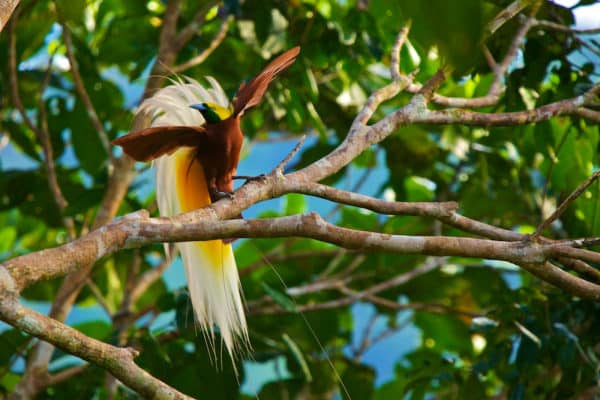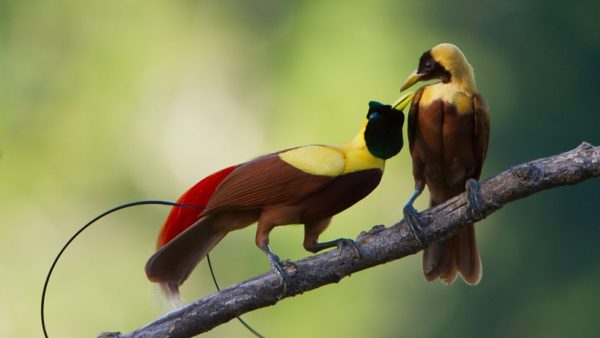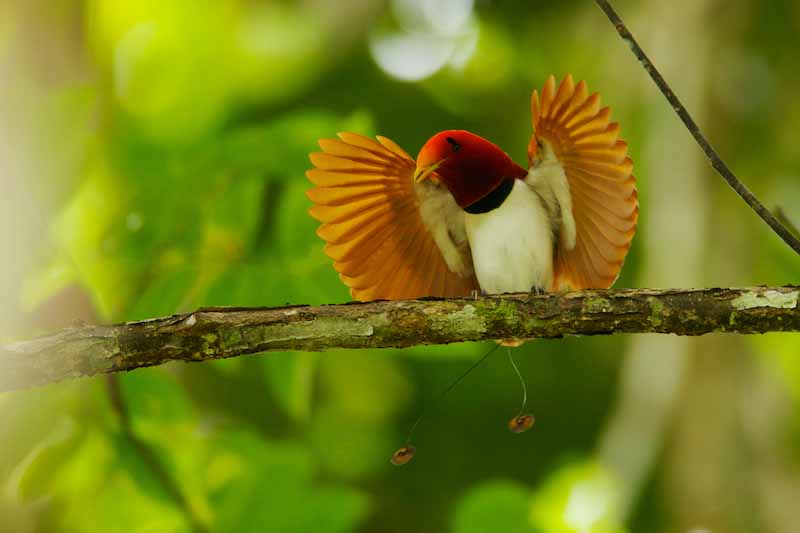Morning dawn and the first sounds of birds chirping, wow… how beautiful is my nature. This is my favorite wake-up call, deep in the thick rainforest, where you can still find those who are always faithful to inhabit the lungs of the earth.
I love the jungle’s playground, especially to meet the beautiful dancers here, our own prima donna. According to the stories of the local people and ancestral myths, they are called fairies who descends from heaven. We call it the Cenderawasih Bird, people from the Middle East call it the Phoenix Bird, and they from the land of Europe and Western Countries call it the Birds of Paradise.
Each must have a reason to be called like that. I, myself wondered why its name was ‘Cenderawasih’. It turned out that the etymology of the word Cenderawasih itself is Cendra or the ‘moon goddess’ and “wasi” means the representative or messenger. So “Cenderawasih” means messenger of the moon gods. From the legend of Egyptian mythology that I read, Phoenix birds whose characteristics are similar to the birds of paradise it a symbol of immortality and they are described as having golden and red feathers. Apparently it is not wrong for people to call them the birds of paradise.
Anyway, apart from the ancient legends and ancestor stories, indeed these birds are heavenly. The birds that we can find here in the forest of Indonesian New Guinea belong to the Paradisaidae family group and are found only in eastern Indonesia (Papua), Papua New Guinea (PNG), and eastern Australia. Consisting of about 43 species and we have at least 18 of them! Wow. . .so special and I am proud that I am able to promote these beautiful birds of our land, to the whole world!
Then what are you waiting for? For you bird and nature lovers, seeing and learning about these endemic birds through books and Bird Park is nice, but how exciting it is if we can take you to see them directly in their natural habitat? Aren’t you curious? Go on and prepare your backpack and photography equipment because this time we will invite you to explore the forest of West Papua. A forest so natural, original, and wild with the best morning spots for our adventurous souls and lovers of the wild. Away from the frenetic city pollution, in the jungles of West Papua, you can watch them singing, flying and dancing without being in the hands of any ignorant hand.
Here are the top 6 Bird of Paradise that you can find with our team.
1. Lesser Bird of Paradise ( Paradisaea Minor)

The Lesser Birds of Paradise are found in lowland rainforests of New Guinea and other adjacent islands. The lesser bird-of-paradise is medium-sized, up to 32 cm-long, maroon-brown with a yellow crown and brownish-yellow upper back. The male has a dark emerald-green throat, a pair of long tail-wires and is adorned with ornamental flank plumes which are deep yellow at their base and fade outwards into white. The female is a maroon bird with a dark-brown head and whitish underparts. It resembles the larger greater bird-of-paradise, but the male of that species has a dark chest, whereas the female is entirely brown (no whitish underparts).
Source: https://en.wikipedia.org/wiki/Red_bird-of-paradise
2. Magnificent Bird of Paradise (Diphyllodes Magnificus)

The magnificent bird-of-paradise is distributed amongst the hill and mid-mountain forests of New Guinea and surrounding islands. Common but seldom seen expect at fruiting trees or displays court. The magnificent bird-of-paradise is small, up to 26 cm-long, with extremely complex plumage. The male has seemingly incandescent yellow wings, an iridescent-green breast shield, blue feet, and is adorned with a yellow mantle on his neck. He has two long, curved, blue-green sickle-like tail feathers. The female is a comparatively drab olive-brown bird with black-barred buffy underparts. She lays two creamy yellow eggs.
Source: https://en.wikipedia.org/wiki/Magnificent_bird-of-paradise
3. Red Bird of Paradise (Paradisaea Rubra)

An Indonesian endemic, the red bird-of-paradise is distributed to lowland rainforests of Waigeo and Batanta islands of Raja Ampat, West Papua. This species shares its home with another bird-of-paradise, the Wilson’s bird-of-paradise. Hybridisation between these two species is not recorded but is expected because it is recorded for many other birds-of-paradise. The Red BoP large up to 33 cm long, brown and yellow with a dark brown iris, grey legs and yellow bill. The male has an emerald green face, a pair of elongated black corkscrew-shaped tail wires, dark green feather pompoms above each eye and a train of glossy crimson red plumes with whitish tips at either side of the breast. The male measures up to 72 cm long, including the ornamental red plumes that require at least six years to fully attain. The female is similar but smaller in size, with a dark brown face and has no ornamental red plumes. The diet consists mainly of fruits, berries and arthropods.
Source: https://en.wikipedia.org/wiki/Red_bird-of-paradise
4. Western Parotia (Parotia Sefilata)

The Western Parotia or Arfak Parotia is a medium-sized, approximately 33 cm long, bird-of-paradise with a medium-length tail. Endemic to Indonesia, the western parotia is found only in the mountain forests of Vogelkop and the Wandammen Peninsula of Western New Guinea. The male Western Parotia is a fantastic dancer! He shows a ballerina-like dance with its plumes expanded like a skirt! During his funny and spectacular dance he rapidly moves his head as if he had a bit too much to drink. He has 3 head-wires behind each eyes and a black plumage. The female that likes his moves, will choose him to mate with.
Source: https://en.wikipedia.org/wiki/Western_parotia
5. Wilson’s Bird of Paradise (Diphyllodes Respublica)

An Indonesian endemic, the Wilson’s bird-of-paradise is distributed to the hill and lowland rainforests of Waigeo and Batanta Islands off West Papua and the middle mountain forest. Wilson’s bird-of-paradise is rather small. Males can reach a length of 16 centimetres, while females can reach a length of 16 cm. The male is a red and black bird-of-paradise, with a yellow mantle on its neck, light green mouth, rich blue feet and two curved violet tail feathers. The head is naked blue, with a black double cross pattern on it. The female is a brownish bird with bare blue crown. Males of these birds clear an area of rainforest to create a ‘display court’. Then they perform an elaborate mating dance to impress a potential mate. The male usually exhibits the attractive breast shield and accompanies the mating dance with song and calls.
Source: https://en.wikipedia.org/wiki/Wilson%27s_bird-of-paradise
6. King Bird of Paradise (Cicinnurus Regius)

This so-called “living gem” is the smallest and most vividly colored among birds-of-paradise. The king bird-of-paradise is small, approximately male 16 cm and female 19 cm long. This bird is distributed to the lowland and foothill forest, edge, and second grownth. Common but difficult to observe. The smalllest mainland Bird of Paradise male unique. He sings and displays from a subcanopy tangle of shaded vibes in the forest interior. Song is slow, swelling series of nasal, paradisaea-like notes: rahn rahn rahn rahn . . . or rapid ki kyer kyer kyer kyer kyer. . .The male is crimson and white with bright blue feet and green-tipped fan-like plumes on his shoulder. The two elongated tail wires are decorated with emerald green disk feathers on its tip. The unadorned female is a brown bird with barring below.
This is just a short list, we still have much more. Interested to explore further?
We are ready to realize your trip and always remember to preserve the forest. As a closing we say here; “Burung Irian, Burung Cenderawasih. Cukup Sekian dan Terima Kasih” – Please google it ! Because if I translate, it’s gonna be weird and it will lose the touch of art from a poem. – haha just kidding!
See you in the jungle !
